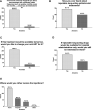Long-acting drugs: people's expectations and physicians' preparedness. Are we readying to manage it? An Italian survey
- PMID: 36281167
- PMCID: PMC9592418
- DOI: 10.1097/MD.0000000000030052
Long-acting drugs: people's expectations and physicians' preparedness. Are we readying to manage it? An Italian survey
Abstract
To evaluate patients' expectations regarding long-acting antiretroviral agents and preferences about where to receive them. Multicenter cross-sectional survey-based study. Through an online survey, we asked people living with human immunodeficiency virus to judge their relationship with daily antiretroviral therapy (ART) and to give their opinion about long-acting drugs. We also collected data regarding the age of the patients, their site of follow-up, time since the diagnosis, and compliance to ART. Two hundred forty-two patients aged 18 to 79 years were included in the study: 58 (24%) females, 182 (75.2%) males, and 2 (0.8%) male-to-female transgenders. 81.8% of the said population had a good relationship with ART. 33.6% of them consider daily ART an obligation and a restriction to their freedom. One hundred forty-three (59.1%) patients already knew about long-acting drugs before our interview, and 215 (88.8%) patients were interested in it. One hundred fifty-six (64.4%) interviewees said they would still be interested in hospital-available injective long-acting drugs, although 57.9% of the patients would rather receive them at home. The data emerging from our survey reveal that around 90% of the people living with HIV are interested in changing their actual treatment with a long-acting one. Moreover, for the first time to our knowledge, such a high number of patients showed an enthusiastic response to the new opportunity to be treated directly at home. The introduction of these new drugs could be revolutionary and represents an important step toward treatment simplification.
Copyright © 2022 the Author(s). Published by Wolters Kluwer Health, Inc.
Conflict of interest statement
The authors have no funding and conflicts of interest to disclose.
Figures




References
-
- European Centre for Disease Prevention and Control. HIV/AIDS surveillance in Europe. 2020. Available at: https://www.ecdc.europa.eu/sites/default/files/documents/hiv-surveillanc.... [access date 13 May, 2021].
-
- Mulato A, Acosta R, Chang S, et al. . Simulating HIV breakthrough and resistance development during variable adherence to antiretroviral treatment. J Acquir Immune Defic Syndr. 2021;86:369–77. - PubMed
Publication types
MeSH terms
Substances
LinkOut - more resources
Full Text Sources
Medical

